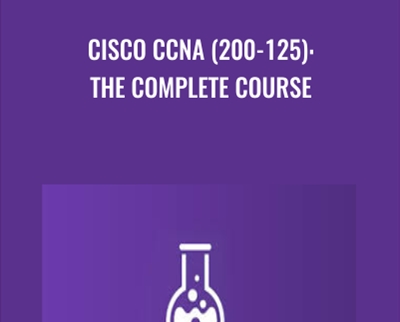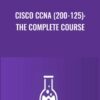$55.00 Original price was: $55.00.$25.00Current price is: $25.00.
This course is for Cisco's newest certification, the CCNA R/S 200-125, that became effective on August 21st, 2016.
This course is all you need to prepare & pass Cisco's new CCNA R/S 200-125 certification exam
 Purchase this course you will earn 25 Points worth of $2.50
Purchase this course you will earn 25 Points worth of $2.50Elevate your skills with the Cisco CCNA (200-125): The Complete Course – Lazaro Diaz course, available for just $55.00 Original price was: $55.00.$25.00Current price is: $25.00. on Utralist.com! Browse our curated selection of over 60,000 downloadable digital courses across diverse Uncategorized. Benefit from expert-led, self-paced instruction and save over 80%. Start learning smarter today!
This course is for Cisco's newest certification, the CCNA R/S 200-125, that became effective on August 21st, 2016.
This course is all you need to prepare & pass Cisco's new CCNA R/S 200-125 certification exam
Laz is notorious for his nonchalant and sometimes, unorthodox way of teaching. Not to mention his achievement in being instrumental in getting his students certified.
This is his latest course for the CCNA R/S and has everything one needs to prepare for the 200-125 certification exam.
The course was produced in a very effective manner where the student would feel as if they are in a classroom setting and the instructor is speaking directly to them.
In Laz's style of teaching, the course is very laid back to make the topics covered more digestible and easier for anyone to understand.
Whether you are a novice or just need a refresher, this course has everything you need to prepare & pass the 200-125 certification.
Students will acquire the knowledge and practice labs in this course to make it transferable to real world use, as a Cisco and/or IT Professional.
DISCLAIMER: Please note that the simulators/emulators used in this course are not part of the course. It is the students responsibility to have these to practice with. The Cisco Packet Tracer & VIRAL (Virtual Internet Routing Lab) are Cisco proprietary software and can only be obtained through Cisco. But students have more options that those. They can create their own lab with real equipment, get BOSON or GNS3. It is up to each student to obtain the simulator/emulator of their choice to study along with this course. Please also NOTE: .pkt files are not up-loadable to this site. This means you would have to replicate the labs here in order to practice and follow along.
This course will give students an in-depth understanding of networking, using routers and switches and their various configurations and connections. Students will learn how to configure; default, static and dynamic routing. Students will comprehend how to manipulate each of the routing protocols attributes to meet the requirements of the network.
This course will also prepare the student in Layer 2 technology and its various configurations, such as; VLAN’s, VTP, STP, PortFast, EtherChannel, Port-Security, Inter-VLAN communication & Trunking; plus the newest requirements needed for the CCNA (200-125) certification exam as well.
Students will also acquire the knowledge needed to secure their routers through the use of Access-list, configuring the different types of NAT & will be able to manage the router’s components.
Students will also be able to thoroughly grasp the concepts of both Internet Protocols; IPv4 & IPv6
Please keep in mind that Laz has his own book called "The Only IP Book You Will Ever Need!" that will further help those that need a more in-depth understanding of IPv4 & IPv6.
Also covered in this course is Wide Area Network Protocols like HDLC, PPP & Frame Relay, BGP, HSRP, MPLS among others
Students will also learn how to create redundancy in their networks through the use of Redundancy Protocols such as HSRP which is just as important. Also, within the WAN, the student will also learn how to create VPN’s and GRE Tunnels among other things that are crucial in passing the new CCNA.
GNS3 Academy Curriculum
Introduction to the CCNA 200-125 Composite Certification
- S1L1 CCNA 200-125 Inroduction to the course (6:32)
Introduction to TCP/IP Networking
- S2L2 Introduction to TCP/IP Networking (4:02)
- S2L3 Perspectives on Networking (8:47)
- S2L4 The Application Layer of the TCP/IP Model (3:09)
- S2L5 the Transport Layer of the TCP/IP Model (4:55)
- S2L6 The Network Layer of the TCP/IP Model (3:21)
- S2L7 The Link and Physical Layer of the TCP/IP Model (2:39)
- S2L8 Summary of Section (3:43)
The Breakdown to the OSI Model
- S3L9 The OSI Model (2:17)
- S3L10 Comparing the OSI and TCP/IP Model (4:56)
- S3L11 OSI Layers and their functions (7:58)
- S3L12 OSI Layering Concepts and Benefits (3:49)
- S3L13 Summary of Section (1:45)
A Look at the Cisco Models
- S4L14 Cisco 3 Layer Model (3:25)
- S4L15 Cisco Collapsed Architecture (2:37)
- S4L16 Summary of Section (2:21)
An Introduction to Ethernet LANs
- S5L17 an Overview of LAN's (3:34)
- S5L18 Small Office Home Office LAN (9:44)
- S5L19 Common Enterprise LAN (11:36)
- S5L20 Ethernet Cabling Standards (8:17)
- S5L21 Summary of Section (2:50)
Nodes used on Ethernet LANs
- S6L22 Devices used on an Ethernet Network (6:32)
- S6L23 Summary of Section (3:48)
Introduction to IPv4 Addressing
- S7L24 Introduction to IPv4 Addressing (10:08)
- S7L25 Format and Classes of an IPv4 Address (11:10)
- S7L26 Classes and private IP Addressing (11:14)
- S7L27 Summary of Section (2:50)
Class-Full Subnetting in IPv4
- S8L28 Class-Full Subnetting in IPv4 (15:35)
- S8L29 Subnetting a Class "C" Address (4:53)
- S8L30 Subnetting a Class "B" Address (4:00)
- S8L31 Subnetting a Class "A" Address (5:14)
- S8L32 Summary of Section (1:21)
VLSM
- S9L33 VLSM (2:43)
- S9L34 VLSM Breakdown (11:41)
- S9L35 Creating a VLSM Network (3:09)
- S9L36 Summary of Section (2:09)
Route Summarization
- S10L37 Route Summarization (2:51)
- S10L38 Summarization Breakdown (5:46)
- S10L39 Assigning the Summary Address (8:04)
- S10L40 Summary of Section (1:26)
Configuration within the CLI
- S11L41 Introduction to Cisco's CLI (2:27)
- S11L42 Navigation of the CLI (11:25)
- S11L43 Cisco Router Components (6:12)
- S11L44 Router Boot Sequence (5:17)
- S11L45 password Recovery Procedure (11:31)
- S11L46 Router Administrative Commands (18:25)
- S11L47 Router interface Commands (9:28)
- S11L48 Summary of Section (4:36)
All About Routing
- S12L49 Routing Packets in your network (9:24)
- S12L50 Default Routing (11:51)
- S12L51 Static Routing (10:23)
- S12L52 Dynamic Routing (2:54)
- S12L53 Configuring RIPv2 (11:41)
- S12L54 Passive Interface (1:47)
- S12L55 Configuring the Passive-Interface (7:29)
- S12L56 RIPv2 Default Routes (1:44)
- S12L57 Configuring RIPv2 Default Routes (7:34)
- S12L58 Summary of Section (3:32)
The EIGRP Routing Protocol
- S13L59 The EIGRP Routing Protocol (19:40)
- S13L60 Basic Configuration of EIGRP (8:43)
- S13L61 The EIGRP Topology Table (6:16)
- S13L62 Successor asnd Feasible Successor Routes (12:42)
- S13L63 The EIGRP Neighbor Table (4:10)
- S13L64 Wildcards to Configure EIGRP (8:28)
- S13L65 Bandwidth in EIGRP (8:25)
- S13L66 Load Balancing with EIGRP (5:31)
- S13L67 Summary of Section (5:32)
All About OSPF
- S14L68 All About OSPF (12:45)
- S14L69 OSPF Basic Lab (7:24)
- S14L70 Designated and Backup Router Lab (20:40)
- S14L71 Multi Area OSPF Lab (12:51)
- S14L72 OSPF Authentication Lab (9:29)
- S14L73 Summary of Section (2:52)
All About Switching
- S15L74 LAN Switching (5:24)
- S15L75 Common Command on a Switch (13:11)
- S15L76 The Spanning Tree Protocol (5:00)
- S15L77 STP Election Process (13:36)
- S15L78 Manipulation of STP (6:55)
- S15L79 Summary of Section (3:15)
All about VLAN's
- S16L80 Vlans in Our Network (4:01)
- S16L81 VLAN Configuration (12:00)
- S16L82 Using the Virtual Trunking Protocol (7:46)
- S16L83 Trunking Ports (10:22)
- S16L84 Securing Ports on a Switch (9:45)
- S16L85 Summary of Section (2:24)
Welcome to Inter-VLAN Routing and EtherChannel
- S17L86 Inter-VLAN Routing (12:04)
- S17L87 Ether-Channel (2:16)
- S17L88 EtherChannel Configuration (16:22)
- S17L89 Summary of Section (2:31)
Welcome to IPv6
- S18L90 The Ins and Outs of IPv6 (19:05)
- S18L91 Assigning IPv6 Addresses to an Interface (12:11)
- S18L92 Static Routing In IPv6 (8:36)
- S18L93 RIPng Configuration (7:20)
- S18L94 EIGRPv6 Configuration (9:57)
- S18L95 OSPFv3 Configuration (9:31)
- S18L96 Dual Stack Routing (10:36)
- S18L97 Subnetting in IPv6 (7:47)
- S18L98 Summary of Section (2:43)
Welcome to Access-List
- S19L99 Unraveling Access-List (7:35)
- S19L100 Standard ACL Configuration (7:30)
- S19L101 Standard ACL's for Telnet (8:38)
- S19L102 Extended ACL Configuration (12:49)
- S19L103 Named ACL Configuration (6:12)
- S19L104 Remark Command in an ACL (7:14)
- S19L105 Summary of Section 19 (1:48)
Welcome to NAT
- S20L106 Network Address Translation (NAT) (7:25)
- S20L107 Configuring Nat Overload (8:54)
- S20L108 Summary of Section 20 (2:47)
Welcome to Wide Area Network (WAN)
- Welcome to WAN (17:34)
- Configuring PPP (20:40)
- Configuring Frame-Relay (19:27)
- Configuring GRE Tunnels (7:50)
- Radius Lab (15:14)
- TACACS+ Lab (12:32)
- IPSLA Lab (21:35)
- Summary of Section (3:59)
Welcome to MPLS
- Welcome to MPLS (12:08)
- The Basics of MPLS (22:04)
- MPLS VPN Layer 2 (22:49)
- MPLS VPN Layer 3 (13:40)
- Summary of Section (3:23)
Welcome to BGP
- Introduction to BGP (7:35)
- Comparison eBGP VS iBGP Lab (14:07)
- Minimal eBGP (8:31)
- Summary of Section (2:23)
Introduction to HSRP
- Introduction to HSRP (20:38)
- HSRP Lab (13:33)
- Summary of Section (1:23)
Intro to DMVPN
- Intro to DMVPN (7:32)
- DMVPN Lab (13:23)
- VPN (3:43)
- Summary of Section (2:05)
IP Services
- Introduction to IP Services (11:07)
- SNMP LAB (12:16)
- Summary of Section (4:26)
Managing a Cisco Internetwork
- Configuring DHCP (11:30)
- DHCP Relay Agent (15:34)
- Verifying DHCP on a Cisco IOS (5:55)
- Network Time Protocol (NTP) (17:00)
- Resolving Hostnames (10:48)
- Summary of Section (3:26)
Evolution of Intelligent Network
- Introduction to Evolution of Intelligent Network (7:44)
- API's (9:33)
- Cisco APIC-EM (6:20)
- summary of Section (5:50)
Licensing
- Licensing a Cisco Router (6:03)
- Licensing Lab (8:37)
- Summary of Section (2:52)
Summary of Course!!
- Summary of Course (12:46)
Extreme Lab Challenge
- Challenge Lab Extreme (10:30)
Quality of Service (QoS)
- QoS Introduction (1:59)
- QoS Lab (29:16)
- QoS Explanation (30:26)
Get Cisco CCNA (200-125): The Complete Course – Lazaro Diaz, Only Price $29
Tag: Cisco CCNA (200-125): The Complete Course – Lazaro Diaz Review. Cisco CCNA (200-125): The Complete Course – Lazaro Diaz download. Cisco CCNA (200-125): The Complete Course – Lazaro Diaz discount.
Cultivate continuous growth with the Cisco CCNA (200-125): The Complete Course – Lazaro Diaz course at Utralist.com! Unlock lifetime access to premium digital content, meticulously designed for both career advancement and personal enrichment.
- Lifetime Access: Enjoy limitless access to your purchased courses.
- Exceptional Value: Benefit from savings up to 80% on high-quality courses.
- Secure Transactions: Your payments are always safe and protected.
- Practical Application: Gain real-world skills applicable to your goals.
- Instant Accessibility: Begin your learning journey immediately after buying.
- Device Compatible: Access your courses seamlessly on any device.
Transform your potential with Utralist.com!
Related products
Uncategorized
= 85 Points
Uncategorized
Managing Geriatric Behaviors: Wandering, Aggression, Malnutrition and More – Steven Atkinson
= 35 Points
= 84 Points
Uncategorized
Legal Risks in Nursing Documentation – Use Extreme Caution When Skimming the Facts – Rosale Lobo
= 40 Points
= 125 Points
= 94 Points
Uncategorized
= 85 Points
Uncategorized
= 85 Points





